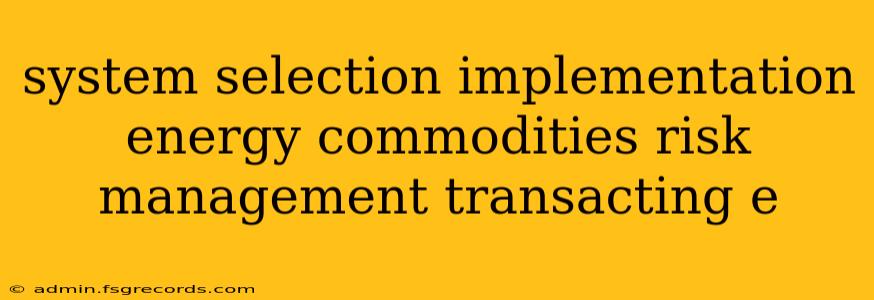The energy commodities market is a complex and volatile landscape. Effectively managing risk and executing transactions requires robust, sophisticated systems. This post delves into the crucial aspects of selecting and implementing such systems, focusing on key considerations for energy traders, producers, and consumers alike.
Understanding Your Needs: The Foundation of System Selection
Before embarking on the system selection process, a thorough understanding of your specific needs is paramount. This involves a comprehensive analysis of your current operations, identifying pain points, and defining your future goals. Key questions to consider include:
-
Trading Strategies: What types of energy commodities do you trade (crude oil, natural gas, electricity, etc.)? What are your primary trading strategies (hedging, speculation, arbitrage)? Understanding your trading style dictates the functionalities required in your risk management system.
-
Data Requirements: What data sources do you need to integrate (market data providers, internal systems, weather forecasts)? The system should seamlessly integrate with your existing infrastructure to provide a holistic view of your market position.
-
Risk Management Objectives: What are your key risk metrics (Value at Risk (VaR), Expected Shortfall (ES), etc.)? How do you measure and mitigate market risk, credit risk, and operational risk? The chosen system should provide comprehensive reporting and analysis tools to effectively manage these risks.
-
Regulatory Compliance: Are you subject to specific regulatory requirements (e.g., Dodd-Frank, EMIR)? The system must be compliant with all relevant regulations.
-
Scalability and Flexibility: Does the system accommodate future growth and expansion into new markets or commodities? The ability to adapt to changing market conditions is critical for long-term success.
-
Integration with Existing Systems: How will the new system integrate with your existing enterprise resource planning (ERP), trading platforms, and other critical systems? Seamless integration minimizes disruption and maximizes efficiency.
Key Features of a Robust Energy Commodities Risk Management System
A successful system should encompass several critical functionalities:
1. Real-time Data Integration and Analysis:
- Market Data Feeds: Access to reliable, high-frequency market data from reputable providers.
- Portfolio Valuation: Accurate and timely valuation of your entire energy portfolio, considering all relevant factors.
- Risk Calculation and Reporting: Sophisticated algorithms for calculating and reporting key risk metrics.
2. Trade Management and Execution:
- Automated Trade Capture: Streamlined capture and processing of trades to minimize errors and delays.
- Order Management: Efficient tools for managing orders, tracking execution, and monitoring positions.
- Algorithmic Trading Capabilities: Options for integrating algorithmic trading strategies for enhanced efficiency and profitability (where appropriate).
3. Comprehensive Reporting and Analytics:
- Customizable Dashboards: User-friendly dashboards providing real-time insights into your portfolio and risk exposure.
- Regulatory Reporting: Automated generation of reports required for regulatory compliance.
- Performance Attribution: Detailed analysis of trading performance to identify areas for improvement.
Implementation: A Phased Approach
Implementing a new risk management system is a complex undertaking. A phased approach is generally recommended:
-
Planning and Requirements Gathering: Define clear objectives, identify key stakeholders, and outline the implementation plan.
-
System Selection and Vendor Evaluation: Carefully evaluate potential vendors and select a system that meets your specific needs.
-
Data Migration: Transferring your existing data to the new system, ensuring data integrity and accuracy.
-
System Testing and Validation: Thorough testing to verify functionality and identify any issues before go-live.
-
Training and User Adoption: Providing comprehensive training to users to ensure effective system utilization.
-
Post-Implementation Support and Maintenance: Ongoing support to address any issues and ensure the system remains optimized.
Conclusion
Selecting and implementing a robust risk management system is a critical investment for any organization operating in the energy commodities market. By carefully considering your specific needs and adopting a phased implementation approach, you can effectively manage risk, optimize trading strategies, and enhance overall profitability. Remember to prioritize a system that is not only technologically advanced but also user-friendly and adaptable to the ever-evolving dynamics of the energy market.

